COMMENTS ON THE ART MARKET
Gallery News
By: Howard
Big Changes Are Coming!
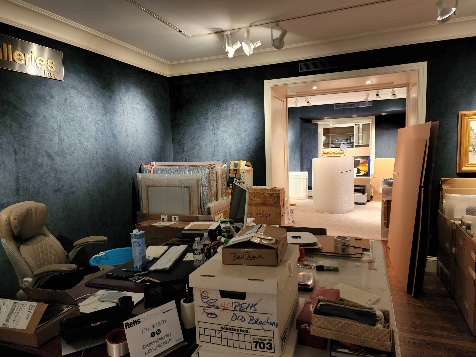 There comes the point when we all need a change, and 2022 appears to be that time for us. For the past 26 years, 5 East 57th Street has been our home. But as our businesses have grown, so has the need for more space. So, as of August 31st, Rehs Galleries, Inc. will no longer be at our current location. In fact, we have decided to close our existing space to visitors starting August 1st, giving us the much-needed time to pack everything up.
There comes the point when we all need a change, and 2022 appears to be that time for us. For the past 26 years, 5 East 57th Street has been our home. But as our businesses have grown, so has the need for more space. So, as of August 31st, Rehs Galleries, Inc. will no longer be at our current location. In fact, we have decided to close our existing space to visitors starting August 1st, giving us the much-needed time to pack everything up.
Now, I am sure you are wondering where we are going? Well, for the next few months, our art will be at UOVO, a beautiful fine art storage facility in Long Island City. In the meantime, we (along with a lot of help from our new landlord) will build our new space at 20 West 55th Street. This new location is more than twice the size of our current space, allowing us to display and store more art and curate multiple exhibitions simultaneously.
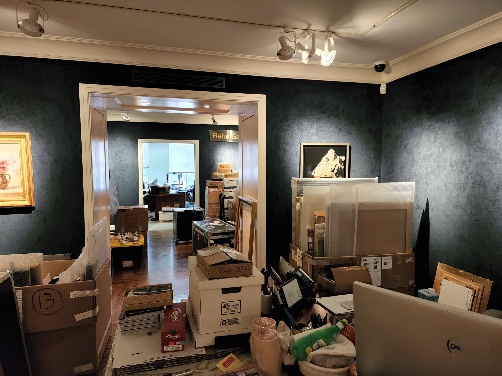 Have no fear; we will still be working seven days a week. Both Rehs Galleries and Rehs Contemporary will participate in several art and antique fairs over the summer and fall seasons: Newport, Nantucket, Baltimore, and Winnetka. As we acquire new works, they will be added to our website, and our weekly updates and monthly newsletter will continue. If you are going to be in New York and would like to see any of our works physically, we can arrange a viewing at UOVO, located on the Queens side of the 59th Street bridge.
Have no fear; we will still be working seven days a week. Both Rehs Galleries and Rehs Contemporary will participate in several art and antique fairs over the summer and fall seasons: Newport, Nantucket, Baltimore, and Winnetka. As we acquire new works, they will be added to our website, and our weekly updates and monthly newsletter will continue. If you are going to be in New York and would like to see any of our works physically, we can arrange a viewing at UOVO, located on the Queens side of the 59th Street bridge.
Our current phone number, (212) 355-5710, will forward to a cell phone, so you can still reach us. If needed, we also ask that you take a moment to update our mailing address: 20 West 55th Street, 5th Floor, New York, NY 10019 (effective September 1, 2022).
We will keep everyone updated on the construction and let you know when we are planning our grand opening – hopefully, supply chain issues won’t have a big impact on us.
Nantucket Is Next
Baltimore Is Back
 We are excited to announce that we will again participate in this fall’s Baltimore Art, Antique & Jewelry Show. The Show, which last took place in 2019, closed in 2020 when Governor Larry Hogan and FEMA made the Baltimore Convention Center into a temporary hospital and mass vaccination site. Well, things are returning to normal (or as normal as they can get).
We are excited to announce that we will again participate in this fall’s Baltimore Art, Antique & Jewelry Show. The Show, which last took place in 2019, closed in 2020 when Governor Larry Hogan and FEMA made the Baltimore Convention Center into a temporary hospital and mass vaccination site. Well, things are returning to normal (or as normal as they can get).
Now celebrating its 40th year, the Baltimore Art, Antique & Jewelry Show returns to the Inner Harbor at the Baltimore Convention Center from October 20-23, 2022. The Show has always been one of the most anticipated collector events of the year, and will welcome back many longtime and new exhibitors who will showcase a wide variety of quality items from all genres.
While this year’s edition will have a different floor plan, Rehs Galleries, Inc. and Rehs Contemporary Galleries, Inc. will be front and center (our booth’s location is 200 – 204 & 301 – 305) and plan to exhibit a similar cross-section of art as we have in the past. We will showcase art from the mid-19th century to some of today’s most sought-after and collectible contemporary artists. Among the artists we plan on featuring include Daniel Ridgway Knight, Julien Dupré, Édouard Cortès, Antoine Blanchard, Eugene Boudin, Louis Valtat, Maurice de Vlaminck, Stuart Dunkel, Todd M. Casey, Julie Bell, Ben Bauer, Ken Salaz, Andrew Orr, Kari Tirrell, and many others.
We will keep you updated on tickets for the Show.
____________________
Stocks & Crypto
By: Lance
It seems that this cold streak we’ve been seeing in the stock market was no match for the July heatwave. Stocks climbed for three consecutive days to close out the month, leading the major indices to their best monthly gains since 2020… the Dow rose 3% in the last week, and 6.7% for the month. The S&P was up 4.3% this past week and 9.1% for the month; and most impressively, the Nasdaq jumped 4.7% last week, with an astounding 12.4% gain for July. The month is in stark contrast from the last 6 months where stock prices have slid heavily into bear market territory… just to be clear, all indications still point to a looming recession, but perhaps things aren’t turning out as bad as forecasters expected a few months ago.
As for currencies and commodities, there was big news with respect to the Euro… in the middle of the month, it was in parity with the US Dollar for the first time in 20 years. It closed out July at $1.02, while the Pound is around $1.22. Both gold and crude futures saw some choppy trading… gold ultimately finished the month about where it started, while Crude is down about 10%, currently just above $98. Fluctuations in the crypto market were dizzying, but ultimately, it was a good month… Bitcoin is up 20%, Litecoin is up 15%, and Ethereum is up almost 60%!
I have no good explanation for any of it… the fed just announced another rate hike and inflation is still very concerning. But hey, gas prices at the pump are down… woo! Then again, I live in NYC and don’t even drive so that’s not doing me any good. Hope you’re all enjoying your summer!
____________________
The Dark Side
By: Nathan
The Orlando Basquiats: An Update
 About a month ago, I wrote about allegations surrounding a collection of Basquiat paintings housed at the Orlando Museum of Art (OMA). The FBI sent agents to the museum last month to investigate claims that scores of alleged Basquiat paintings were complete forgeries. Experts at the time were divided over the issue, with the museum director Aaron de Groft asserting their authenticity. It seems like De Groft is losing ground since the FBI raided OMA on June 24th and confiscated twenty-five museum pieces. If genuine, the Basquiat collection would be worth around $100 million, according to Putnam Fine Art & Antique Appraisals.
About a month ago, I wrote about allegations surrounding a collection of Basquiat paintings housed at the Orlando Museum of Art (OMA). The FBI sent agents to the museum last month to investigate claims that scores of alleged Basquiat paintings were complete forgeries. Experts at the time were divided over the issue, with the museum director Aaron de Groft asserting their authenticity. It seems like De Groft is losing ground since the FBI raided OMA on June 24th and confiscated twenty-five museum pieces. If genuine, the Basquiat collection would be worth around $100 million, according to Putnam Fine Art & Antique Appraisals.
The museum erased all material about their planned Basquiat exhibition, Heroes & Monsters, from their website. Furthermore, two days after the raid, the museum board of trustees removed De Groft from his position as museum director. It was especially damning when someone leaked an email between De Groft and a Basquiat expert, Jordana Moore Saggese. Professor Saggese previously authenticated the works in her book Reading Basquiat, but the email revealed why she previously gave a positive attribution to these forgeries. When Saggese wrote to De Groft asking to break off her involvement with the exhibition, De Groft admitted to paying her for her attribution and further pressured her into acquiescing: “You want us to put out there you got $60 grand to write this? Ok then. Shut up. […] Be quiet now is my best advice. These are real and legit. You know this. You are threatening the wrong people. Do your academic thing and stay in your limited lane.” It’s not illegal or out of line to charge a fee for an expert’s authentication. But forking over a sum of money enough to buy a new Mercedes E-Class just for a simple attribution in a book seems like De Groft was desperate for more experts to back him up. It’s unknown whether his decades of experience as an art historian gave him an extra dose of pride or if he wanted to cover his tracks after realizing his mistake.
So far, no charges have been filed, and museum officials have ensured complete cooperation with the FBI. According to the FBI, the federal government has investigated this particular collection because not long after it was discovered in a Los Angeles storage unit auction nearly a decade ago. Investigators may have been tipped off since some of the owners of the alleged Basquiats, including the art dealer William Force and the trial lawyer Pierce O’Donnell, have been previously involved in some suspicious art deals. In 2014, Force and salesman Leo Mangan were sued for selling forged works allegedly by Jackson Pollock. Two years later, O’Donnell represented himself in a lawsuit over another Pollock fake.
I’d let the FBI conclude their investigation before any finger-pointing happens… but it’s difficult not to point fingers at the paintings’ owners and Aaron de Groft. With the works in the FBI’s custody, the federal investigation will likely yield some fruit soon enough.
Artemisia Stopped At The Border
 When it comes to women in the visual arts, there are a lot of names that may come to mind. But one of the characteristics many popular female artists have in common, whether Georgia O’Keeffe or Yayoi Kusama, Lee Krasner or Frida Kahlo, is that many of them lived and worked in the modern era. However, the one who paved the way for all of them lived centuries ago. Artemisia Gentileschi is considered one of the greatest Italian artists of the seventeenth century. She is mainly known today for her scenes of women’s empowerment from the Bible, classical mythology, and history. Judith, Bathsheba, and Cleopatra have all been given Gentileschi’s shadow-cloaked treatment at one point or another. And now, Italian authorities have recently intercepted one of her paintings about to be shipped off to Austria for auction.
When it comes to women in the visual arts, there are a lot of names that may come to mind. But one of the characteristics many popular female artists have in common, whether Georgia O’Keeffe or Yayoi Kusama, Lee Krasner or Frida Kahlo, is that many of them lived and worked in the modern era. However, the one who paved the way for all of them lived centuries ago. Artemisia Gentileschi is considered one of the greatest Italian artists of the seventeenth century. She is mainly known today for her scenes of women’s empowerment from the Bible, classical mythology, and history. Judith, Bathsheba, and Cleopatra have all been given Gentileschi’s shadow-cloaked treatment at one point or another. And now, Italian authorities have recently intercepted one of her paintings about to be shipped off to Austria for auction.
Rather than showing a famous woman, real or fictional, the painting Caritas Romana has a more allegorical subject. Meaning Roman Charity in Latin, the work shows the story of a woman breastfeeding her father after he is sentenced to death by starvation. While the story has been popular in the visual arts since the ancient period, the subject was particularly popular in the seventeenth century. In addition to Gentileschi, other Renaissance and Baroque masters like Peter Paul Rubens and Pieter van Mol have created their own renditions of the subject. For years, the Gentileschi Caritas Romana was thought to have been created by one of her students or followers. However, Italy’s Cultural Heritage Protection Unit has been investigating the work for around two years. The painting’s owners, it seems, planned on selling the work at an auction house in Vienna, trying to circumvent Italian cultural heritage and customs authorities by deliberately withholding relevant historical documentation. The Cultural Heritage Protection Unit has stated that the work is worth around €2 million.
Looted Art? There’s A Museum For That
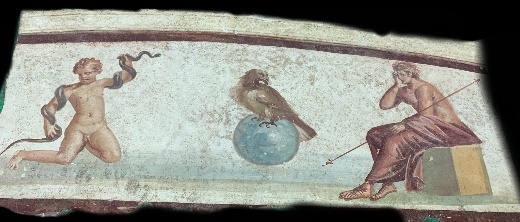 The British Museum gets a lot of flak for its reputation of housing stolen or looted artifacts from around the world. The fact that the British government refuses to repatriate the Parthenon Marbles looted from Athens certainly did not help. And now, in Rome, there’s a museum exclusively dedicated to stolen art. But this one is for art about to be returned to their places of origin. The Museo dell’Arte Salvata, or the Museum of Rescued Art, opened last month at the Baths of Diocletian, a property used partly by Italy’s National Roman Museum.
The British Museum gets a lot of flak for its reputation of housing stolen or looted artifacts from around the world. The fact that the British government refuses to repatriate the Parthenon Marbles looted from Athens certainly did not help. And now, in Rome, there’s a museum exclusively dedicated to stolen art. But this one is for art about to be returned to their places of origin. The Museo dell’Arte Salvata, or the Museum of Rescued Art, opened last month at the Baths of Diocletian, a property used partly by Italy’s National Roman Museum.
When it comes to “rescued” art, there are a lot of works that fall under that categorization. Art is rescued when it is confiscated from thieves and looters; or when it is salvaged from shipwrecks. Art can even be rescued when it undergoes extensive restoration. The museum’s first exhibit, running until October 15th, is dedicated to art repatriated to Italy after being stolen. After the exhibition is over, the exhibit contents will be returned to art and cultural institutions closest as possible to their places of origin.
The museum’s opening comes at a very opportune time. This past Wednesday, July 20th, the Manhattan district attorney Alvin Bragg turned over one hundred forty-two artifacts to the Italian consul-general in New York. The artifacts are estimated to be worth a total of around $14 million. Of this haul, sixty items were those seized from Royal-Athena Galleries in Midtown Manhattan, a now-closed antiquities dealership once operated by the late Jerome Eisenberg. Forty-eight pieces once belonged to the American billionaire and antiquities collector Michael Steinhardt. Last year, Steinhardt received a lifetime ban on dealing in antiquities and was forced to hand over about $70 million worth of artifacts.
Probably the most famous of Steinhardt’s items in this latest batch of artifacts is what is known as the Ercolano Fresco. It is part of an ancient Roman wall looted from Herculaneum, one of the Roman cities destroyed in the 79 CE eruption of Mount Vesuvius that also buried Pompeii. The fresco depicts the classical hero Hercules as a child, killing a snake wrapped around his arms. This is in reference to a story where Hercules, son of the god Jupiter and the mortal Alcmene, escaped death when he killed two snakes placed in his crib by Jupiter’s wife Juno. Steinhardt purchased the fresco in 1995 for around $650K, and the artifact is now estimated to be worth $1 million. This newest group of items will likely be displayed at the Museum of Rescued Art in Rome, but nothing has been officially arranged yet.
____________________
The Art Market
By: Nathan
Bonhams New Bond Street Old Masters Sale
 On Wednesday, July 6th, the Bonhams New Bond Street location hosted their Old Masters sale. There were some impressive pieces up for sale, but Bonhams specialists were probably a little surprised when the results came in. Not many of their predicted top lots amounted to much. Not only did some go unsold, but the pieces that brought in the most for Bonhams seemed to have come out of nowhere. Originally, Bonhams specialists expected Bartolomeo Passarotti’s Portrait of a Collector and Edward Collier’s A trompe l’oeil still life to bring in a minimum of £200K and £100K, respectively. Both ended up going unsold. The only highly valued lot that did as expected was A black and white spaniel by the English painter George Stubbs. The moderately-sized oil painting hit its low estimate when the hammer came down at £200K / $237.9K (£252.3K / $300.1K w/p). But the Stubbs work confirms a theory I’ve held for some months now: the auction house is no different from social media and the Internet. If a dog is involved, it will get more attention. This theory started with Sotheby’s Impressionist sale in Paris and Bonhams 19th Century sale back in April.
On Wednesday, July 6th, the Bonhams New Bond Street location hosted their Old Masters sale. There were some impressive pieces up for sale, but Bonhams specialists were probably a little surprised when the results came in. Not many of their predicted top lots amounted to much. Not only did some go unsold, but the pieces that brought in the most for Bonhams seemed to have come out of nowhere. Originally, Bonhams specialists expected Bartolomeo Passarotti’s Portrait of a Collector and Edward Collier’s A trompe l’oeil still life to bring in a minimum of £200K and £100K, respectively. Both ended up going unsold. The only highly valued lot that did as expected was A black and white spaniel by the English painter George Stubbs. The moderately-sized oil painting hit its low estimate when the hammer came down at £200K / $237.9K (£252.3K / $300.1K w/p). But the Stubbs work confirms a theory I’ve held for some months now: the auction house is no different from social media and the Internet. If a dog is involved, it will get more attention. This theory started with Sotheby’s Impressionist sale in Paris and Bonhams 19th Century sale back in April.
The other two top lots that accompanied the Stubbs spaniel were also some of the biggest surprises the sale had to offer. The top lot was a rather small, oil-on-panel work by an unknown artist entitled Adam and Eve in the Garden of Eden. While the artist’s identity is unknown, art historians have attributed several other pieces to the same hand. So because we’re only able to identify the artist by their particular style, experts have given this painter a provisional name: Master of the Embroidered Foliage. While estimated to sell between £25K and £30K, several buyers were dead-set on acquiring this little biblical scene, driving the hammer price up to £640K / $761.3K (£806.7K / $959.6K w/p). This was a whopping twenty-one times more than the specialists’ high estimate. This is particularly impressive since the work last sold at Christie’s London in 1934 for a mere £819. That would equal about £41K in 2021, but even that’s pretty remarkable. Coming in third place, another surprise to the Bonhams specialists, was A brown thoroughbred by the English equestrian painter James Seymour. It’s a rather large work, measuring almost two-and-a-half feet by four-and-a-half feet, which experts thought would go for £50K at most. But the hammer came down two-and-a-half times that, with the horse and rider going for £125K / $148.7K (£157.8K / $187.7K w/p).
The only downside to the sale was that out of seventy-three available lots, thirty-four of them (44%) went unsold. However, for those that sold, Bonhams experts achieved a pretty decent accuracy rate, with twenty-two lots (30%) selling within their estimates. The entire sale brought in £1.4M (or $1.7M), slightly over the total minimum estimate; thanks, of course, to the Master of the Embroidered Foliage!
Christie’s London Old Masters Sale
On Thursday, July 7th, Christie’s London hosted its Old Masters sale, capping off a string of Old Masters sales held the previous week at London’s other major auction houses. While the sale did rather well, there were a few disappointing moments.
The sale’s top lot was The Nymph of the Spring by Lucas Cranach the Elder. It initially seemed a little underwhelming, not much different from some of the other Renaissance and Baroque nudes by masters like 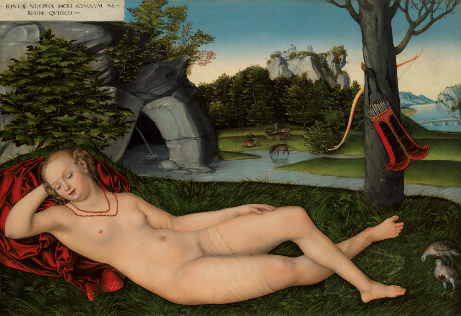 Titian or Rubens. But the more I read about it, the more I understood that multi-million pound price tag. Mythical nudes were a common subject for Cranach, who created twelve different works entitled Nymph of the Spring. This one, however, is the largest of the bunch, measuring almost three feet by four feet. While Cranach’s first works featuring the reclining, nude nymph date to around 1518, specialists can date this particular nymph to about 1540 to 1545. This is known because of a small white symbol painted on the tree in the foreground: a winged serpent, which Cranach used as his signature starting around 1537. The work also has an incredible provenance. It appears to have been in the Holy Roman Emperor Rudolph II’s collection before being looted by Swedish troops at the end of the Thirty Years’ War in 1648. Afterward, it was placed in the collection of Sweden’s Queen Christina, one of the most interesting women of early modern Europe. For several centuries, it remained in Sweden, bouncing around between several prominent collections, including that of Count Gustav Adolf Sparre, one of the top art collectors of the eighteenth century; it finally ended up in a UK collection. Bidding for the Cranach stopped at its high estimate, with the hammer coming down at £8M / $9.6M (or £9.5M / $11.3M w/p).
Titian or Rubens. But the more I read about it, the more I understood that multi-million pound price tag. Mythical nudes were a common subject for Cranach, who created twelve different works entitled Nymph of the Spring. This one, however, is the largest of the bunch, measuring almost three feet by four feet. While Cranach’s first works featuring the reclining, nude nymph date to around 1518, specialists can date this particular nymph to about 1540 to 1545. This is known because of a small white symbol painted on the tree in the foreground: a winged serpent, which Cranach used as his signature starting around 1537. The work also has an incredible provenance. It appears to have been in the Holy Roman Emperor Rudolph II’s collection before being looted by Swedish troops at the end of the Thirty Years’ War in 1648. Afterward, it was placed in the collection of Sweden’s Queen Christina, one of the most interesting women of early modern Europe. For several centuries, it remained in Sweden, bouncing around between several prominent collections, including that of Count Gustav Adolf Sparre, one of the top art collectors of the eighteenth century; it finally ended up in a UK collection. Bidding for the Cranach stopped at its high estimate, with the hammer coming down at £8M / $9.6M (or £9.5M / $11.3M w/p).
The house specialists’ predictions also proved correct regarding the Anthony Van Dyck Portrait of a Carmelite Monk. Like the Cranach nymph, the Carmelite Monk also has an interesting provenance. Not long after its creation, it was bought by one of Van Dyck’s contemporaries, the Flemish master Peter Paul Rubens. The portrait remained the property of Rubens’s descendants until it was sold at Sotheby’s London in 2011 for £713.3K w/p. Whoever bought it back then certainly made a pretty penny since the priestly portrait sold for its low estimate at £2.8M / $3.4M (or £3.4M / $4.1M w/p). Tying with the Van Dyck, Jacob van Ruisdael’s A wooded landscape also brought in £2.8M for Christie’s. The landscape was last sold in 1977 at Sotheby’s Amsterdam location. One issue for anyone looking into that sale is that in 1977 the Netherlands still used the Dutch guilder (ƒ). Nowadays, the guilder is a defunct currency, having been replaced by the euro in 2004. Some research and a little arithmetic led me to guess that the ƒ740K the landscape sold for in 1977 was equal to about $300K at the time (around $1.45M in today’s money).
Now, I mentioned that the sale was a little disappointing in some regards. This was mainly because of Antonio Canova’s sculpture Maddalena Giacente, or the Recumbent Magdalene. The work made headlines back in March when Christie’s announced it would be included in this Thursday’s sale. It has an incredible story behind it since it’s considered a rediscovered lost work after spending decades outdoors as a garden statue in west London. House experts at Christie’s expected the statue to reach anywhere between £5M and £8M. However, it became clear that the Canova’s reserve was set at the low estimate because the work was bought in when bidding stalled at £4.8M. This was another example of how a single lot can make or break a sale. Had the Canova sold at £4.8M, the sale would have made its total estimate. However, because it went unsold, the entire sale accumulated £23.2M (or $27.8M), or £1M short of expectations. Twenty-nine of the thirty-five available lots sold, with six selling within estimate and eleven selling over. Not too bad, but still a bit disappointing all because of just one lot.
Bonhams Knightsbridge Modern British & Irish Sale
On Wednesday, July 13th, Bonhams’ Knightsbridge saleroom in London hosted their Modern British & Irish sale. While Sotheby’s hosted a similar sale that day, the Bonhams sale did far better than their counterparts across town. Well, most sales would probably fare better than Sotheby’s European & British sale, since forty-six percent of the lots went unsold. Bonhams, on the other hand, was very successful that day.
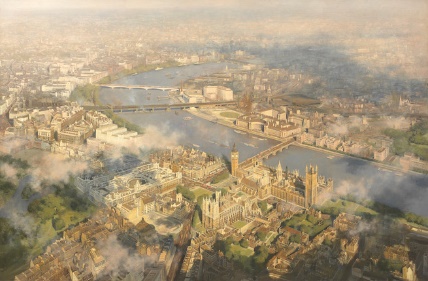 Bonhams specialists did very well, with most of the higher-valued lots selling within their estimates. The top lot was what the specialists predicted: Aerial View of Westminster by the British wildlife artist David Shepherd, who passed away in 2017. The work was done in oil paint on a massive canvas, measuring a little over five feet by eight feet. The size is necessary to achieve such meticulous detail, giving the viewer an incredible view of central London from the north bank of the Thames. Most impressive are the spires on the Palace of Westminster, the flying buttresses at Westminster Abbey, and the exhaustive work done to place an innumerable amount of cars and red double-decker buses on Westminster, Jubilee, and Waterloo Bridges. Though Bonhams experts predicted the panorama would fetch £50K at most, the cityscape brought in £88K / $105K (or £111.2K / $132.7K w/p). Coming in second, though expected to bring in more than Shepherd’s Aerial View, Terence Cuneo’s Night Express – Southern Region has, until now, been in the same private collection since its commission in 1976. Despite this being its first time coming to auction, the work only hit its £40K low estimate, the equivalent of $47.7K (or £50.7K / $60.5K w/p). Finally, there was the 1951 oil painting Les Baux by Frederick Gore, which was actually one of the sale’s little surprises. It’s a moderately-sized work, measuring about twenty by twenty-four inches. It’s also in the very distinct style of the artist, who in the 1950s was considered one of the top figurative artists when many well-known painters were experimenting with abstract forms. Despite all that, Les Baux was only predicted to go for between £4K and £6K. But it ended up more than doubling its high estimate when the hammer came down at £14K / $16.7K (or £17.9K / $21.3K w/p).
Bonhams specialists did very well, with most of the higher-valued lots selling within their estimates. The top lot was what the specialists predicted: Aerial View of Westminster by the British wildlife artist David Shepherd, who passed away in 2017. The work was done in oil paint on a massive canvas, measuring a little over five feet by eight feet. The size is necessary to achieve such meticulous detail, giving the viewer an incredible view of central London from the north bank of the Thames. Most impressive are the spires on the Palace of Westminster, the flying buttresses at Westminster Abbey, and the exhaustive work done to place an innumerable amount of cars and red double-decker buses on Westminster, Jubilee, and Waterloo Bridges. Though Bonhams experts predicted the panorama would fetch £50K at most, the cityscape brought in £88K / $105K (or £111.2K / $132.7K w/p). Coming in second, though expected to bring in more than Shepherd’s Aerial View, Terence Cuneo’s Night Express – Southern Region has, until now, been in the same private collection since its commission in 1976. Despite this being its first time coming to auction, the work only hit its £40K low estimate, the equivalent of $47.7K (or £50.7K / $60.5K w/p). Finally, there was the 1951 oil painting Les Baux by Frederick Gore, which was actually one of the sale’s little surprises. It’s a moderately-sized work, measuring about twenty by twenty-four inches. It’s also in the very distinct style of the artist, who in the 1950s was considered one of the top figurative artists when many well-known painters were experimenting with abstract forms. Despite all that, Les Baux was only predicted to go for between £4K and £6K. But it ended up more than doubling its high estimate when the hammer came down at £14K / $16.7K (or £17.9K / $21.3K w/p).
However, the Frederick Gore wasn’t the only big surprise that day. In fact, the very first lot across the block turned out to be the biggest surprise of the sale. Henry Lamb’s painting Sketch for Family Group is only about nine by nine inches and was valued at £1,200 maximum. So the day started with a pretty impressive bang when bidders went back and forth on the work for a few minutes, driving up the final hammer price to land at £11.5K / $13.7K (or £14.7K / $17.5K w/p). You know it’ll probably be a good sale when the very first lot fetches over nine times what the house specialists predicted it would. Out of two hundred six available lots, Bonhams house experts gave accurate estimates for sixty-five of them, or about 32%. An additional seventy-two lots, or 35%, sold for over their estimates. All in all, only thirty-eight of the two hundred six lots went unsold, giving Bonhams a sold rate of 82%.
Christie’s London British & European Sale
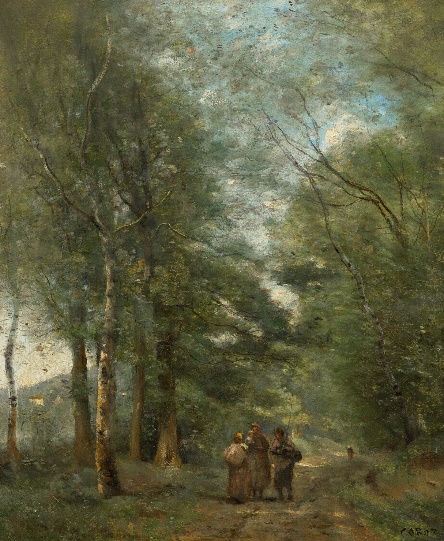 On Friday, July 15th, Christie’s London held their British & European art sale. The auction came at the end of a week where several other London auction houses, like Sotheby’s and Bonhams, held similar sales. While the former fared rather poorly, the latter did particularly well. So the outcome of the Christie’s sale seemed rather up in the air going into it (all prices given are hammer prices unless the added buyer’s premium is indicated with “w/p”). The house specialists gave great attention to the Sir Alfred James Munnings scene entitled The Shortcut. They expected it to be the sale’s star, using its image for promotional material. The painting, created around 1911, shows a rider in a red fox-hunting jacket leading his horse over a footbridge. Until Friday’s sale, it was in the continuous possession of the Colman family, a prominent eastern English business and political family (known for their brand of mustard, among some other things). Christie’s experts estimated the Munnings to go for as much as £250K. While the Munnings was among the sale’s top lots, it failed to reach its pre-sale estimate and reached only second place at £140K / $165.6K (£176.4K / $208.7K w/p). Meanwhile, a wooded, pastoral landscape by Jean-Baptiste-Camille Corot took the sale’s top spot instead. The Corot painting, showing peasants on a country lane outside Paris, was already highly valued by the specialists since it last sold at auction at Sotheby’s London in 2016 for £125K w/p. But it reached more than double its £120K high estimate, with the hammer coming down at £280K / $331.3 (£352.8K / $417.4K w/p).
On Friday, July 15th, Christie’s London held their British & European art sale. The auction came at the end of a week where several other London auction houses, like Sotheby’s and Bonhams, held similar sales. While the former fared rather poorly, the latter did particularly well. So the outcome of the Christie’s sale seemed rather up in the air going into it (all prices given are hammer prices unless the added buyer’s premium is indicated with “w/p”). The house specialists gave great attention to the Sir Alfred James Munnings scene entitled The Shortcut. They expected it to be the sale’s star, using its image for promotional material. The painting, created around 1911, shows a rider in a red fox-hunting jacket leading his horse over a footbridge. Until Friday’s sale, it was in the continuous possession of the Colman family, a prominent eastern English business and political family (known for their brand of mustard, among some other things). Christie’s experts estimated the Munnings to go for as much as £250K. While the Munnings was among the sale’s top lots, it failed to reach its pre-sale estimate and reached only second place at £140K / $165.6K (£176.4K / $208.7K w/p). Meanwhile, a wooded, pastoral landscape by Jean-Baptiste-Camille Corot took the sale’s top spot instead. The Corot painting, showing peasants on a country lane outside Paris, was already highly valued by the specialists since it last sold at auction at Sotheby’s London in 2016 for £125K w/p. But it reached more than double its £120K high estimate, with the hammer coming down at £280K / $331.3 (£352.8K / $417.4K w/p).
Coming up in third was John Atkinson Grimshaw’s Autumn Morning, which was last up at auction at Sotheby’s New York in 1992, where it sold for $52,250 w/p. It’s a typical Grimshaw scene, with the top of an old manor house visible in the background. The viewer’s focus is drawn to the old stone gate crawling with ivies, which stand out against the golden leaves scattered about on the paving stones leading up to the house. This time, Autumn Morning did significantly better, falling within its estimate and selling for £110K / $130.1K (or £138.6K / $164K w/p).
While some of the available lots did very well, most lots did not bring in as much as expected, while many others did not even sell. Fifty-eight of the one hundred sixty-five lots, or around 35%, went unsold. Christie’s specialists predicted almost twenty of these unsold works to make as high as £50K or £70K, including other works by Grimshaw and Munnings. Autumn Morning was the only one of the four works by Grimshaw that sold on Friday. There were also many unsold Venetian cityscapes by nineteenth and early twentieth-century painters like Félix Ziem, Martín Rico, Rubens Santoro, and Federico del Campo. But it wasn’t complete doom-and-gloom, as there were some nice little surprises throughout the sale. Franz Richard Unterberger’s Venetian scene Rio San Girolamo was only due to make £12K, but it ended up bringing in almost four times that. The hammer ended up coming down at £70K / $82.8K (or £88.2K / $104.4K w/p). When it comes to sales that do relatively poorly overall, the unexpected surprises become all the more special. On top of the unsold lots, an additional sixty-two works, or 38%, sold below their pre-sale estimates. All in all, only twenty-eight works sold within their estimates, or about 17% of the total number of available lots. This resulted in the sale only making £1.8M (or $2.13M), falling short of the £2.68M minimum estimate put forth by Christie’s experts.
____________________
Deeper Thoughts
By: Nathan
A Princely Palace With More Secrets
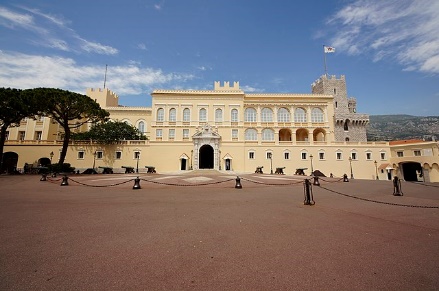 The Prince’s Palace of Monaco is considered one of the finest royal residences in Europe, and it is also one of the only palaces in Europe still in use by a crowned head of state. The Prince’s Palace, or the Palais Princier, has belonged to the Grimaldi family for over seven hundred years. The family has also held the title Prince of Monaco for as long as they’ve owned the palace. Initially built by the Genoese in the late twelfth century as a fortress, the palace has expanded with new wings and other extensions added during the Renaissance and Baroque periods. While still a functioning royal residence, the Prince’s Palace is mainly a tourist attraction. The state rooms are open to the public during summer, while the main courtyard often hosts concerts and other events. But now, after an extensive, eight-year restoration, past visitors can see some of the palace’s treasures for the first time.
The Prince’s Palace of Monaco is considered one of the finest royal residences in Europe, and it is also one of the only palaces in Europe still in use by a crowned head of state. The Prince’s Palace, or the Palais Princier, has belonged to the Grimaldi family for over seven hundred years. The family has also held the title Prince of Monaco for as long as they’ve owned the palace. Initially built by the Genoese in the late twelfth century as a fortress, the palace has expanded with new wings and other extensions added during the Renaissance and Baroque periods. While still a functioning royal residence, the Prince’s Palace is mainly a tourist attraction. The state rooms are open to the public during summer, while the main courtyard often hosts concerts and other events. But now, after an extensive, eight-year restoration, past visitors can see some of the palace’s treasures for the first time.
During the project, restorers uncovered several Renaissance frescoes. Based on the style and the use of lime-based plaster, specialists believe they’re likely the work of a Genoese painter from around the sixteenth century. The frescoes depict scenes from classical mythology, like the twelve labors of Hercules, which were painted over in the nineteenth century. Over six hundred square meters of frescoes have been uncovered throughout the palace: around the courtyard, the ceilings of the many salons, and even the throne room. In recent years, Prince Albert II has tried to recover many of the princely family’s collections that were lost over the years, mainly during the Napoleonic Wars when the palace was looted several times. Today, visitors can view works by Jacopo Bassano, Orazio de Ferrari, and Philippe de Champaigne that once belonged to the Grimaldi family. So now, these newly reacquired treasures can stand alongside the treasures hiding under some paint. The palace state rooms will remain open to the public until October 15th.
Photo credit: Niels Mickers CC BY 3.0 NL <https://creativecommons.org/licenses/by/3.0/nl/deed.en>, via Wikimedia Commons
Italy Says No To NFTs
The Italian Ministry of Culture has halted state-run museums from entering contracts with tech companies to mint NFTs. Massimo Osanna, Italy’s Director-General of Museums, stated, “Given that the matter is complex and unregulated, the ministry has temporarily asked its institutions to refrain from signing contracts relating to NFTs. The basic intention is to avoid unfair contracts.” By “unfair contracts”, Osanna is likely referring to what happened in Florence earlier this year.
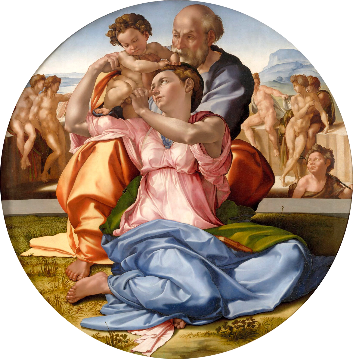 Florence’s Uffizi Gallery is one of the world’s most famous, most respected art institutions. Botticelli’s Birth of Venus, Da Vinci’s Annunciation, and Titian’s Venus of Urbino, among many other masterworks, are included in the museum’s collection. But as the effects of the pandemic taught us, even centuries-old institutions like the Uffizi can be vulnerable and require outside help to stay afloat. The Uffizi and at least five other Italian state-run museums are currently or have previously been engaged in contracts with the NFT start-up Cinello to license images from their collections to mint digital works. Major museums in Italy and beyond began exploring this new realm years ago, as early as 2016. But these same museums started focusing more on digital works at the start of the pandemic. This was because major museums needed to diversify their income sources after seeing their annual visitorship decline by around 70%. To be fair, Cinello has done their job rather well, minting several digital works based on Uffizi collection highlights, such as Caravaggio’s Bacchus and Raphael’s Madonna of the Goldfinch. But the NFT based on Michelangelo’s Doni Tondo has gotten the most attention since it was the first to sell. The sale, which was finalized earlier this year, may have been seen as a landmark moment for digital arts. But the Italian Culture Ministry failed to see the silver lining. In their opinion, the museum got screwed.
Florence’s Uffizi Gallery is one of the world’s most famous, most respected art institutions. Botticelli’s Birth of Venus, Da Vinci’s Annunciation, and Titian’s Venus of Urbino, among many other masterworks, are included in the museum’s collection. But as the effects of the pandemic taught us, even centuries-old institutions like the Uffizi can be vulnerable and require outside help to stay afloat. The Uffizi and at least five other Italian state-run museums are currently or have previously been engaged in contracts with the NFT start-up Cinello to license images from their collections to mint digital works. Major museums in Italy and beyond began exploring this new realm years ago, as early as 2016. But these same museums started focusing more on digital works at the start of the pandemic. This was because major museums needed to diversify their income sources after seeing their annual visitorship decline by around 70%. To be fair, Cinello has done their job rather well, minting several digital works based on Uffizi collection highlights, such as Caravaggio’s Bacchus and Raphael’s Madonna of the Goldfinch. But the NFT based on Michelangelo’s Doni Tondo has gotten the most attention since it was the first to sell. The sale, which was finalized earlier this year, may have been seen as a landmark moment for digital arts. But the Italian Culture Ministry failed to see the silver lining. In their opinion, the museum got screwed.
While the Ministry never made much of a fuss about NFTs before, this latest decision comes after the details of the Uffizi’s contract with Cinello came to light. According to the agreement between the start-up and the museum, the Uffizi would receive half of any profits from NFTs produced based on the museum’s collection. A fair arrangement, it seems. However, according to this contract, the museum’s half would also exclude any tax, commission, production costs, etc. In the end, the Uffizi only received €70K of the €240K made in the sale, just under a third rather than half. So the government is saying that the museum got gouged, more or less.
Possibly because of some controversy surrounding NFTs, Cinello claims they do not produce NFTs. Rather, they create what they call digital artworks (DAWs), sometimes called digitally-encrypted works. Despite the different name, it uses NFT tokens created on a blockchain. Cinello has also clarified that the rights to the images used in their blockchain-based works remain with the museums. Therefore, the owner of this digital work is not allowed to have it exhibited publicly, nor can they license the work to be used in other media. It’s solely for your private enjoyment. To be honest, it might be better to buy a plane ticket to Florence, buy a ticket for general admission to the Uffizi, and purchase an overpriced poster of the work. It would still be a more fulfilling experience and significantly cheaper than buying this NFT or DAW or whatever set of initials you want to use. The creation and selling of the Doni Tondo NFT seemed needlessly more complicated than it had to be. And overall, the culture ministry may be making the right move to err on the side of caution in the face of this unregulated new medium.
Frida: The Musical
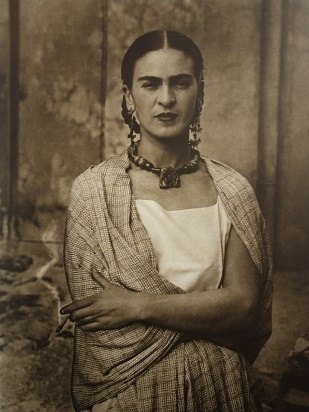 Whether it’s the life of a South American president’s wife, a tale of Mormon missionaries in Uganda, or the rise and fall of that guy on the ten-dollar bill, musicals can come from some pretty strange and disparate places. You never can tell what’s going to play well with audiences when in pre-production. But one of the ways writers and producers try to tap into mass appeal is to make a “bio-musical”. Telling real-life stories seems to resonate with people, whether it’s the six wives of Henry VIII, or the Von Trapp family, or Annie Oakley. But sometimes it works, and sometimes it doesn’t. So some are feeling either excitement or alarm since BTF Media announced a new musical is in the works based on the life of Frida Kahlo.
Whether it’s the life of a South American president’s wife, a tale of Mormon missionaries in Uganda, or the rise and fall of that guy on the ten-dollar bill, musicals can come from some pretty strange and disparate places. You never can tell what’s going to play well with audiences when in pre-production. But one of the ways writers and producers try to tap into mass appeal is to make a “bio-musical”. Telling real-life stories seems to resonate with people, whether it’s the six wives of Henry VIII, or the Von Trapp family, or Annie Oakley. But sometimes it works, and sometimes it doesn’t. So some are feeling either excitement or alarm since BTF Media announced a new musical is in the works based on the life of Frida Kahlo.
The new project, known by the working title Frida: The Musical, already has ten songs by the Mexican composer Jaime Lozano and the American lyricist Neena Beber. Two songs were recently performed as part of the American Songbook series at New York’s Lincoln Center. This is rather big news since many have attempted to adapt Kahlo’s life for the stage. In 2014, producers put out a casting call for a Frida musical called Tree of Hope, named after her painting of the same title. I can’t find anything that shows that Tree of Hope amounted to anything. But this new attempt at bringing Kahlo’s life to the stage is the first time the Kahlo estate has signed off on a musical adaptation. This may indicate that perhaps this may not be as kitschy as similar projects (I’m looking at you, Diana: The Musical).
Producers state that the musical will be “a full-throated celebration of Kahlo’s joyous spirit of creativity and her unmatched gift for transforming physical and emotional pain into breathtaking beauty.” The plot will cover her international trips to Paris and New York, her relationship with Diego Rivera, and her celebration of her native Mexico. It will be tough for whoever is cast in the title role to fill the enormous shoes the artist left behind.
The Rehs Family
© Rehs Galleries, Inc., New York – August 2022
